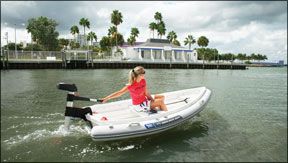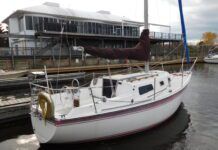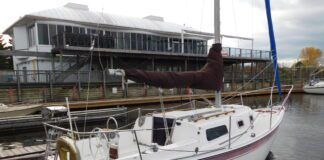Three things attracted us to the long-shaft Torqeedo: It is a light motor; it is a portable motor; and it is an electric motor. The dream of being able to easily tuck the daysailers engine in the cuddy cabin, or tool around silently in our dinghy, is alluring. And the Torqeedos detachable, rechargeable battery makes that possible. Unfortunately, two of the features that we find so attractive are also potential trouble spots.
****
The new Torqeedo Travel 801 electric outboard was introduced last autumn, and
Practical Sailorwas among the first to obtain the engine for evaluation. This is an ultra-light, folding, electric outboard engine with a sophisticated motor and an integral lithium manganese battery that is easily detached from the engine for charging. The Torqeedo company, based in Germany, also offers two other models, the Cruise 2.0, which uses a separate battery and is designed for larger boats (up to 6,000 pounds displacement), and the Travel 401, which has the same design as the Travel 801 but half the power.

If you are interested in electric motors, the theory of propulsion, and advances in lithium manganese battery storage, the Torqeedo website provides a fairly intensive study. From the companys perspective, it has spared no expense to deliver the most efficient electric propulsion available, and it has some independent testing to back up this claim.
Compared to the trolling motors we tested two years ago (“Trolling Motor Test,” November 15, 2005), the Torqeedos AC motor reflects a big leap in efficiency. The Torqeedos 10Ah integral battery delivers limited run time (see test results, below), but it is adequate, and remarkable compared to what can be practically achieved with much heavier Group 27 (110 Ah) lead-acid wet cells coupled with the motors in our 2005 test. For greater range, the Torqeedo has an optional adapter to tap into wet cells, or you can buy a second battery ($600).
Three things attracted us to the Torqeedo: It is light; it is portable; and it is electric. The dream of being able to easily tuck the daysailers motor in the cuddy cabin, or tool around silently in our dinghy, is alluring.
Unfortunately, two of the features that we find so attractive are also potential trouble spots. To keep weight down, the Torqeedo is mostly plastic, and anodized aluminum (protected by sacrificial anodes).
None of the plastic components on our test Torqeedo broke, but several small components on the tiller assembly and mounting bracket do not qualify as robust, in our opinion. The motor and microprocessor are sealed in the lower unit (under water while operating), and the battery and charger clip into contacts that will need to be carefully protected.
It is perhaps not fair to compare the Travel 801 to an internal combustion outboard engine, but internal combustion engines are the historical standard for this use, so those are the terms by which we evaluated the Torqeedo. Is the Torqeedo Travel 801 reliable, efficient propulsion? Or is it like John Steinbecks cursed outboard in the
The Log from the Sea of Cortez, a possessed contraption that took peculiar delight in tormenting humans. And, lastly, is it worth the $1,400 price tag?
Our first experiences were not good. The battery twice delivered less than 7 minutes of running time before losing steam. We were told this was likely a “software problem” in the earliest models. (Even Steinbecks “stellar sea cow” didnt have software bugs.) Later tests with another battery and discussions with owners who have used the Torqeedo extensively have convinced us that this problem has since been fixed.
With a new battery, the engine sprang to life, and handily met manufacturers performance claims. (A direct comparison between our data and Torqeedos is impossible, since the two refer to different test vessels and sea conditions.)
According to Torqeedo, this motor will push an 11-foot inflatable dinghy at 3.5 knots for 2.5 miles. They also claim a maximum range of 10 miles at just under 1.5 knots. Data for other, larger boats is also provided, but the inflatable was the closest to our own test boat, a Walker Bay RID 275. The double-digit “maximum range” numbers&emdash;given for a variety of craft in the Torqeedo brochure&emdash;look pretty exciting, until you actually putter around at 1.5 knots, and realize that this is not moving, it is&emdash;in Florida at least&emdash;baking.
The Torqeedo has a stepless variable thrust in forward and reverse as well as three fixed settings: fixed time (optimized for battery life in minutes), fixed distance (optimized for one hour of propulsion), and short-term maximum thrust (less than 5 minutes at a time). Our test unit was the long-shaft model, a short shaft version is also available.
How We Tested
Rather than try to match Torqeedos claimed maximums, we used the engine as one would on a dinghy or small sailboat&emdash;with a mixture of accelerating, cruising, slowing down. Here is what we found.
Test One:
On board the same boat that was used in our small outboard motor test (December 2006), an eight-foot Walker Bay RID 275, testers throttled around for a few minutes in flat water, amazed at the little motors power. Too soon, however, the battery capacity was down to 20 percent&emdash;the equivalent of being on the reserve tank. Top speed 4.6 knots. Run time 6 minutes.
Test Two:
Same test, slightly more chop. Same disappointing results.
Test Three:
Success. With the new battery, we were able to tool around as we would when using the dinghy. With one person on board, the boat covered a total of 2.6 nautical miles in 55 minutes. At that point, the engine hit the 20 percent mark. The operating regimen could be broken down like this: 18 minutes at 2 knots (fixed time setting); 23 minutes at 3.5 knots (max thrust setting); 14 minutes at speeds of 3.5 knots, with brief spurts of 4.3 knots (variable thrust). With two testers in the RID, we were able to hit a maximum speed of 4.6 knots and cruise with maximum thrust at 3.5 knots.
Test Four:
We mounted the Torqeedo on a 260-pound, 14-foot ODay Javelin, loaded down with approximately 250 pounds of water, passengers, and gear. We cruised for 15 minutes and 0.6 miles, and still had 60 percent of battery life remaining. Maximum speed was 4.6 knots.
Conclusion
The Torqeedo Travel 801L is clean, quiet and surprisingly powerful. Its light (27 pounds with the battery), but thats only two pounds less than a Honda 2 horsepower, our best choice for small gas outboards. Well-cared for, it will serve well on a dinghy whose primary mission is to reach a boat on a mooring. It also makes for a great little engine for a daysailer that needs a push into and out of a marina, canal, or slip. For light dinghy propulsion while long-term cruising, a gasoline outboard remains a more practical choice.
CONTACTS:
TORQEEDO
847-726-0054, torqueedo.com




































